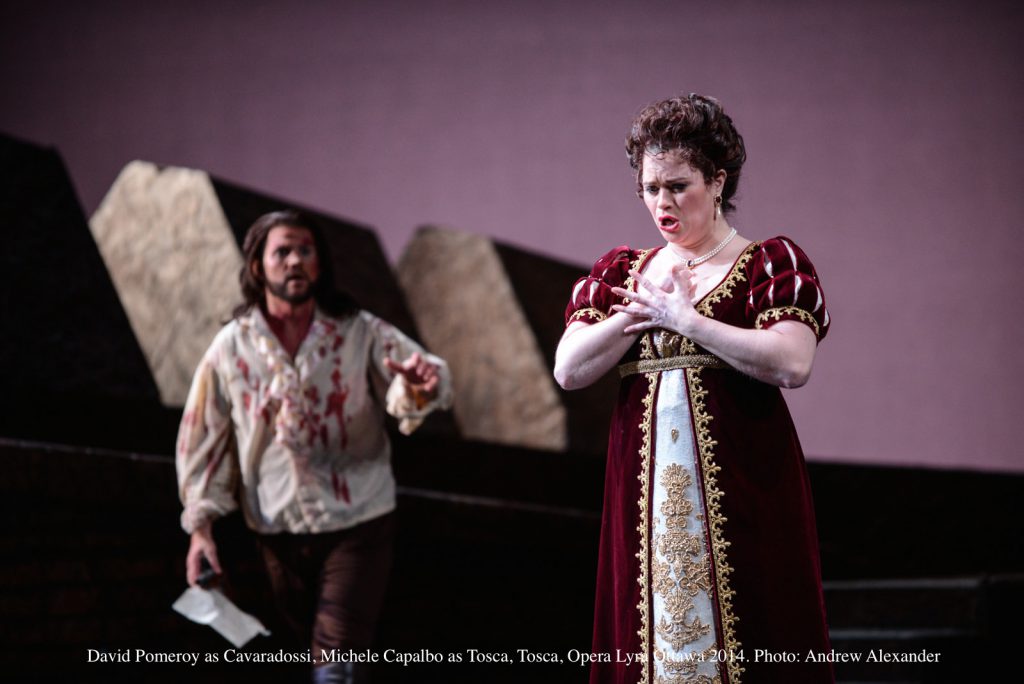Giulio Ricordi was on a mission. The visionary entrepreneur, heir to his grandfather’s flourishing music publishing empire, was determined to find a successor to the great architect of Italian Romantic opera, Giuseppe Verdi. A recent graduate of the Milan Conservatory caught Ricordi’s eye. “We feel Puccini has this precious quality of having ideas of his own,” he announced excitedly. Acutely aware of his protégé’s impatience with unaccommodating librettists, Ricordi, assuming the role of nineteenth century super-agent, assigned experienced professionals Luigi Illica and Giuseppe Giacosa to collaborate. The pair did not disappoint, eventually handing Puccini the essential ingredients for a trio of box office hits bookended by La bohème and Madama Butterfly. At centre stage stood Tosca.
Puccini had long shared Ricordi’s enthusiasm for the project, an operatic adaptation of the red hot stage play by French sensationalist Victorien Sardou, after seeing the touring version starring Sarah Bernhardt in Florence in 1895. Instantly reanimated after four years of false starts by sly, calculated hints from Ricordi that he intended to replace him with a more focused composer, Puccini threw himself at his unfinished score. A year later, his sizzling shocker made its debut in Rome. Authorities gasped at the sex and violence. The audience devoured every moment.
Framing Puccini’s incendiary masterwork in a taut period production backed by spare, moody sets, Opera Lyra Ottawa underscores Tosca’s turbulent timeframe, a full hundred years before the opera’s original premiere.
1800. Napoleon has marched into Italy bringing a legion of noble Revolutionary ideals to the troubled peninsula. In Rome, the decadent remnant of an oppressive Bourbon monarchy struggles to retain its hold on power, brutally repressing all opposition.
Cesare Angelotti, an escaped political prisoner, bursts into the Church of Sant’ Andrea della Valle. Unlocking the secluded chapel reserved for his sister, the Marchesa Attavanti, the terrified fugitive darts inside. An irascible old Sacristan enters followed a few moments later by the painter Mario Cavaradossi. The artist has nearly completed his latest commission, a striking portrait of Mary Magdalene modelled after the Marchesa whom he has often observed at prayer. The Sacristan shuffles off, muttering disapproval. Angelotti, recognizing his friend and supporter, steps from the shadows. Cavaradossi’s lover, the beguiling singer Floria Tosca, is heard calling from the nave. Mario bundles Cesare back into hiding with a little food to sustain him. Tosca, pre-occupied by eternal feelings of suspicion and mistrust, instantly recognizes the cursed Attavanti woman depicted far too lovingly for her tastes. Cavaradossi takes Tosca in his arms. Soothed, she departs. A distant canon booms from Castel Sant’ Angelo announcing a convict has escaped. Angelotti flees with Mario to the safety of the painter’s villa. Baron Scarpia, ruthless chief of police, dashes into the church. His men search the sanctuary. An empty food basket is found in the Attavanti chapel along with a fan bearing the Marchesa’s crest. Scarpia shows it to Tosca, back to collect Mario for a scheduled rendezvous that night, deliberately provoking her to another fit of jealousy. The Baron orders Tosca followed as she storms out of the church to confront her lover, his lust for her as fevered as his desire to trap the elusive Angelotti and Mario, his suspected ally.
Dining alone at his headquarters in the Palazzo Farnese, Scarpia revels in his plans. Spoletta, his zealous lieutenant, enters. He and his subordinates have been unable to find Angelotti but Cavaradossi has been snared. Mario is brought before him. Deaf to Scarpia’s demands to reveal Angelotti’s whereabouts, he is led away to be tortured. A tense round of questioning similarly fails to extract any leads from Tosca who has been plucked from a nearby singing engagement. Suddenly Mario’s screams echo through the palace. Tosca panics, betraying Angelotti’s hiding place in Mario’s garden. Bleeding and beaten, Cavaradossi is dumped at her feet. Word arrives that Angelotti has evaded capture by taking his own life. Scarpia volunteers to spare Mario if Tosca yields to his depravity. Desperate, Tosca agrees. A mock execution will be held for the sake of show followed by Cavaradossi’s release. Orders are dispatched and duly signed. Scarpia is about to seduce his prey when Tosca snatches a knife from his supper table and kills him. Calmly laying out candles to light his corpse, she slips from the room.
Imprisoned in the Castel Sant’ Angelo, Mario struggles to express his love in a letter to Tosca. Much to his surprise, Floria dashes into the scene. Breathlessly revealing the night’s events, she quickly rehearses him on how best to play his part before a mock firing squad. The marksmen take their places. Shots ring out. Mario slumps to the ground. Floria scrambles to his side as the soldiers depart only to discover, to her horror, that Mario’s execution has been genuine. Scarpia’s treachery extends beyond the grave. Spoletta rushes out of the shadows. He and his henchmen have discovered their chief lying lifeless in a pool of blood. Taunting them with a cry to God, Tosca leaps to her death from a parapet before she can be taken.
Traditionally, the haughty diva’s ultimate grand exit, is arguably the opera’s most memorable moment, eagerly anticipated by adoring Tosca-lovers, a scene not soon forgotten. To abandon the episode is to invite certain controversy. Dusting off an arcane alternate ending to La Tosca, the stage play, invented to satisfy squeamish New York audiences in 1889, Opera Lyra director Guy Montavon recalls the Cavaradossi firing squad to dispatch Puccini’s heroine with a second volley of musket shots. It is a curious directorial decision, banal and decidedly unsatisfying. Fortunately, from a musical standpoint, this Tosca retains every echo of its immensely rewarding score, largely redeeming the production’s lone misstep.
Puccini’s use of leitmotifs in Tosca, while far from Wagnerian in scope and development, is nevertheless striking and highly charged. Snatches of arias, breezy melodies, recurring phrases all act as signposts, illuminating a character’s innermost emotional state, cheerful and romantic at times, menacing at others. Under the assured direction of conductor Tyrone Paterson, the National Arts Centre Orchestra floods cavernous Southam Hall with Puccini’s ocean of through-composed sound, endlessly variable and nuanced. Act II is particularly rich in musical signatures referencing all principals at one time or another as the action builds relentlessly from torture, to assault and ultimately murder. Scarpia’s ominous three-chord fanfare shading to hints of calculated dissonance in the brasses is positively chilling, played here with stirring resonance.
Tone painting, a Puccini specialty, is much in evidence in Tosca reaching a climax in the opera’s concluding act. Musical tints and textures are as subtle as they are boundless. Dawn breaks softly over Rome. The music slowly brightens. A shepherd boy sings. Church bells proclaim matins. The hues darken as our attention turns to Cavaradossi and the deadly reality of his impending execution. An aria unfolds. Our hearts are broken. Maestro Paterson and musicians work considerable orchestral magic, weaving a riveting scenic spell as indeed they do throughout the entire course of this sumptuous Tosca. Tempi are brisk, harmonies lush, orchestral colours rich and deep.
In the opera’s title role, Waterloo-born singer actor Michelle Capalbo employs her dusky spinto dramatic soprano with singularly theatrical success. Although somewhat constrained by her earthy timbre in intensely lyrical moments, Capalbo nevertheless fully engages with Puccini’s heroine, performing with appealing commitment and energy. The sorrow and sadness of Tosca’s legendary lament, Vissi d’arte (“I have lived for art”), is given powerful voice by Capalbo, presented with deft paradoxical understatement.
Newfoundland tenor David Pomeroy is an engaging Cavaradossi, embodying the full measure of the character’s humanity. A frequent visitor to the Canadian Opera Company’s Toronto mainstage, Pomeroy brings an appealing directness and an utter lack of affectation to his role, his warm, polished voice movingly matched by a keen dramatic ability. His rendition of Puccini’s magnificent Act III aria, E lucevan le stelle (“And the stars would be shining”), glows with vitality. Duets and responsive recitative shared with Capalbo are deeply affecting, the two striking conspicuous sparks off one another, vocally and emotionally. Pomeroy’s generosity of spirit is palpable. A rare quality of likeability comes pouring over the footlights.
As Tosca’s nexus of evil, baritone Todd Thomas sings an intensely sinister Scarpia dripping with honeyed malevolence, terrifyingly credible. Puccini’s sadistic villain is a challenge for any artist, difficult to realize as three dimensional. Thomas delivers a character of great complexity, pious, manipulative, insightful, even charming when required. It is a terrifying rendering.
The Opera Lyra Chorus, consigned by the libretto to a single scene, Tosca’s bustling Te Deum, sings with an admirable sense of purpose and common cause.
Comprimari are solid in all acts. Giles Tomkins is a suitably tormented Angelotti. Thomas Hammons is a fine cantankerous Sacristan. Dion Mazerolle is Scarpia’s black-hearted henchman, Sciarrone. With his sweet choirboy alto, Matthew Muggeridge is especially memorable as the Young Shepherd. Raphaël Suquet sings the role on alternate nights.
This has been a troubled Tosca. Baritone Valerian Ruminski, contracted to sing the Sacristan, was dismissed after posting a disturbing homophobic remark on Facebook. Peter Strummer, Ruminski’s initial replacement, suffered a recurrence of chronic back problems precluding an appearance. James MacLennan, the production’s Spoletta, fell seriously ill on opening night and had to be replaced by chorister Chris Oliveira singing offstage.
Bringing opera to life is inevitably an exercise in creative problem-solving. With this crisp, explosive Tosca, Opera Lyra has shown itself to be a skilled professional player on the Canadian arts stage.


